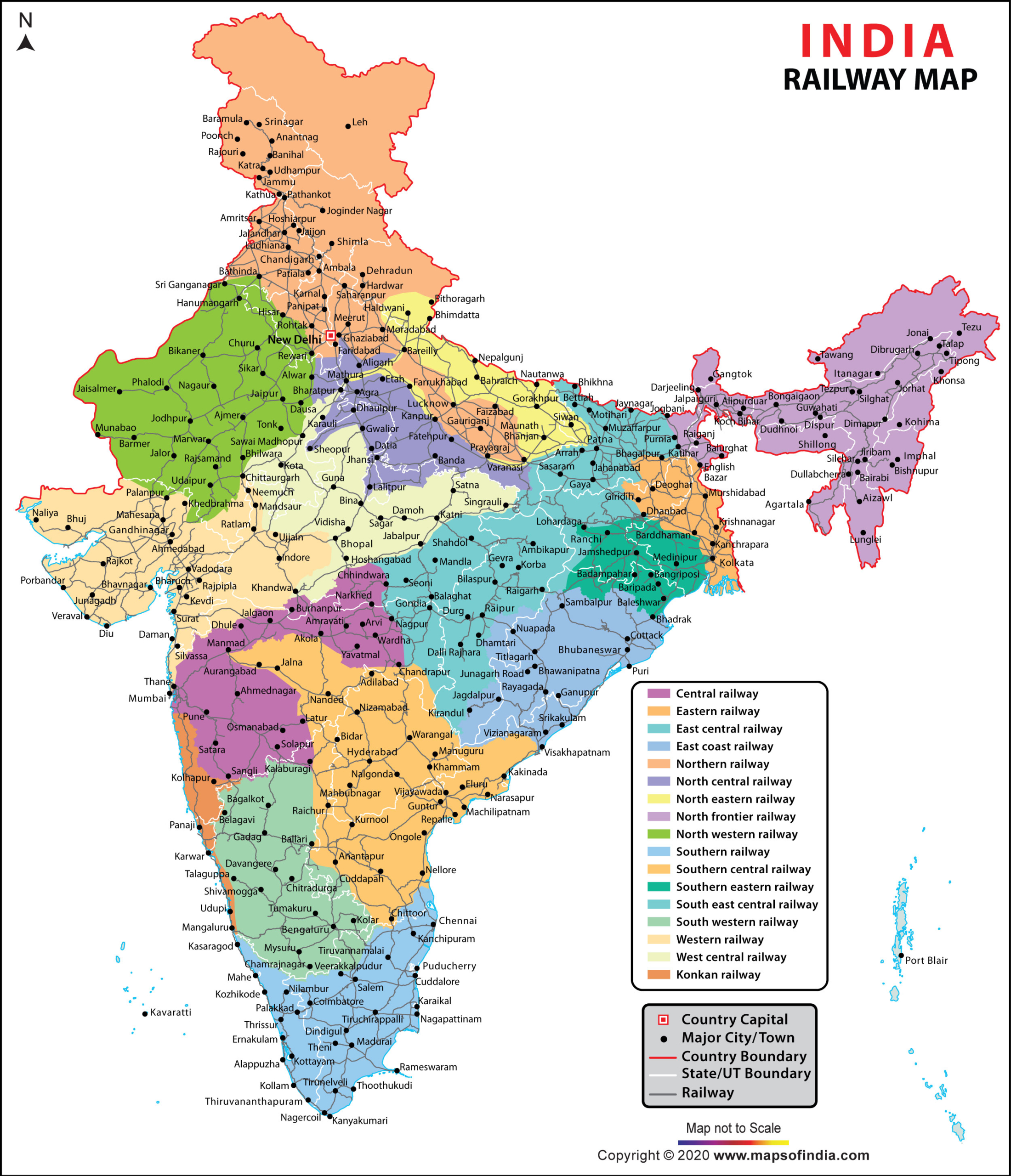Indian Railways, the world’s fourth largest railway network under single management, operates over 32,000 trains, carrying 24 million passengers and 1512 million tonnes of freight. This includes 22,593 scheduled passenger trains (express, mail, superfast, and local) and 8,500 freight trains, with data suggesting over 18,500 active passenger trains in 2025. Special, maintenance, and other non-scheduled trains would further amplify the network’s numbers.
Railway network and infrastructure
As of 31 March 2023, Indian railway network spanned 68,584 km (42,616 mi) in route length. Track sections are rated for speeds ranging from 80 to 200 km/h (50 to 124 mph), though the maximum speed attained by passenger trains is 160 km/h (99 mph). As of March 2023, Indian Railways manages and operates 7,308 stations. Indian Railways categorizes the stations by commercial importance into three different categories namely Non Suburban Group (NSG), Suburban Group (SG) and Halt Group (HG). These are further subdivided into subcategories based on their commercial importance (NSG 1–6, SG 1-3 and from HG 1–3).
Indian Railways, one of the world’s largest rail networks under single management, is divided into zones for efficient administration and operational control. These zones further divide into divisions, each responsible for specific geographic areas. Understanding the zonal structure is crucial for grasping the complexity and scale of India’s railway operations.

Historical Development: Initially, Indian Railways comprised numerous independent railway companies. Post-independence, the process of consolidation and nationalization led to the formation of zones to streamline management. The first six zones were established in 1951, and the network has gradually expanded to the current structure.
| Zone (Code) | Headquarters | Establishment | Divisions | Major Stations | Major States |
|---|---|---|---|---|---|
| Central Railway (CR) | Mumbai CST | 1951 | 5 | Mumbai CST, Pune, Nagpur, Bhusawal | Maharashtra, Madhya Pradesh, Karnataka |
| Eastern Railway (ER) | Kolkata | 1952 | 4 | Howrah, Sealdah, Asansol, Patna | West Bengal, Bihar, Jharkhand |
| East Central Railway (ECR) | Hajipur | 2002 | 2 | Patna, Dhanbad, Mughalsarai | Bihar, Jharkhand, Uttar Pradesh |
| East Coast Railway (ECoR) | Bhubaneswar | 2003 | 3 | Visakhapatnam, Bhubaneswar, Khurda Road | Odisha, Andhra Pradesh, Chhattisgarh |
| Northern Railway (NR) | New Delhi | 1952 | 5 | New Delhi, Delhi Jn., Ambala, Moradabad | Delhi, Haryana, Punjab, Himachal Pradesh, J&K |
| North Central Railway (NCR) | Prayagraj | 2003 | 3 | Allahabad, Kanpur, Agra | Uttar Pradesh, Madhya Pradesh |
| North Eastern Railway (NER) | Gorakhpur | 1952 | 5 | Gorakhpur, Lucknow, Varanasi | Uttar Pradesh, Bihar, Jharkhand |
| Northeast Frontier Railway (NFR) | Maligaon (Guwahati) | 1958 | 5 | Guwahati, New Jalpaiguri, Katihar | Assam, West Bengal, Tripura, Nagaland, etc. |
| North Western Railway (NWR) | Jaipur | 2002 | 4 | Jaipur, Jodhpur, Bikaner | Rajasthan, Haryana, Punjab, Gujarat |
| Southern Railway (SR) | Chennai | 1951 | 6 | Chennai Central, Chennai Egmore, Madurai | Tamil Nadu, Kerala, Puducherry |
| South Central Railway (SCR) | Secunderabad | 1966 | 6 | Secunderabad, Hyderabad, Vijayawada | Telangana, Andhra Pradesh, Karnataka, Maharashtra |
| South East Central Railway (SECR) | Bilaspur | 2003 | 4 | Bilaspur, Raipur, Nagpur | Chhattisgarh, Madhya Pradesh, Maharashtra |
| South Eastern Railway (SER) | Kolkata | 1955 | 4 | Howrah, Kharagpur, Adra | West Bengal, Jharkhand, Odisha |
| South Western Railway (SWR) | Hubballi | 2003 | 3 | Hubballi, Bengaluru, Mysuru | Karnataka, Goa, Andhra Pradesh, Maharashtra |
| Western Railway (WR) | Mumbai Churchgate | 1951 | 6 | Mumbai Central, Vadodara, Ahmedabad | Maharashtra, Gujarat, Rajasthan, Madhya Pradesh |
| West Central Railway (WCR) | Jabalpur | 2003 | 3 | Jabalpur, Bhopal, Kota | Madhya Pradesh, Maharashtra, Rajasthan |
| Metro Railway (MR) | Kolkata | 1984 | 1 | Dum Dum, Kavi Subhash, Noapara | West Bengal (Kolkata Metro) |
| Konkan Railway (KR) | Navi Mumbai | 1998 | 1 | Roha, Ratnagiri, Madgaon | Maharashtra, Goa, Karnataka, Kerala |
The 19th zone of Indian Railways, the South Coast Railway (SCoR), was proposed with its headquarters in Visakhapatnam, Andhra Pradesh, in February 2019. However, it has not yet been fully operationalized.
SCoR was intended to include Guntakal, Guntur, and Vijayawada divisions from existing zones, but it remains in the planning stage without formal notification or operational setup.
The term “19th zone Metro Railway Kolkata” is incorrect because the Kolkata Metro is already recognized as the 17th zone of Indian Railways, established in 1984/2010.
Functions of Railway Zones:
- Operations Management: Controlling train operations within their respective zones, including scheduling, maintenance, and safety.
- Infrastructure Development: Planning and executing infrastructure projects like track laying, electrification, and station upgrades.
- Revenue Management: Managing ticket sales, freight charges, and other revenue streams.
- Human Resources: Recruiting, training, and managing railway personnel within the zone.
- Passenger Amenities: Providing and maintaining passenger amenities at stations and on trains.
Divisional Structure: Each zone is further divided into divisions, which handle operational and administrative tasks at a more localized level. Divisions are responsible for specific sections of track, stations, and train operations within their jurisdiction.
Significance of Zonal and Divisional Structure:
- Decentralized Administration: Dividing the vast network into zones and divisions allows for more efficient and localized management.
- Operational Efficiency: Improves operational efficiency by assigning responsibility for specific geographic areas.
- Resource Allocation: Facilitates better allocation of resources based on the needs of different regions.
- Improved Accountability: Creates clearer lines of accountability for performance and service delivery.
The zonal and divisional structure of Indian Railways is a crucial aspect of its organizational framework. This system allows for efficient management of the complex network, ensuring smooth operations and facilitating continued development and modernization of India’s vital railway infrastructure.
Citation: 17 zones gov press release Rail transport wikipedia